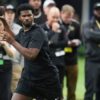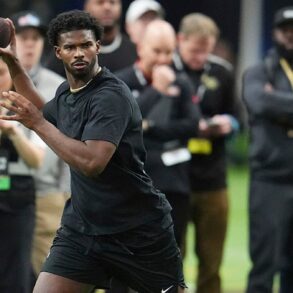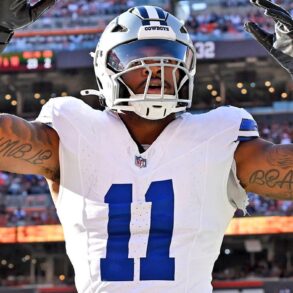Texas A&M defensive end Shemar Stewart is 6-foot-5 and 267 pounds. He ran the 40-yard dash at the NFL combine in February in 4.59 seconds to go along with a 40-inch vertical jump and a 10-foot, 11-inch broad jump.
But he also had just 4.5 sacks in 37 career games for the Aggies.
It’s a glaring stat to consider when a major part of a defensive end’s job is to get to the quarterback — Penn State edge Abdul Carter, a consensus top-five pick, had 12 sacks last year alone.
And it’s why NFL Network’s Daniel Jeremiah calls Stewart, a projected first-round pick in Thursday’s draft, “easily the most polarizing edge rusher.”
“He is the ultimate example of traits versus production,” Jeremiah said on a conference call this week. “He has got all kinds of twitch, he’s explosive, he’s disruptive. He just hasn’t been able to finish, to compile sacks.”
NFL front offices must decide in the coming days whether Stewart’s elite physical attributes are worth more than his questionable sack total. After all, selecting prospects is more than just looking back at college production. It’s about how a player could turn out long term under a professional coaching staff.
“It opens the door for a really interesting conversation about a guy that disrupts plays but doesn’t finish plays and has the size and athleticism that you want at the NFL level,” NBC Sports draft analyst Connor Rogers said. “How high do coaches and evaluators value that?”

Picking a high-ceiling, low-floor prospect is nothing new. There have been many players who dominated in the NFL combine — showing out in categories like the vertical jump, the broad jump, the bench press and 40-yard dash — without the college stats to back it all up. Some NFL evaluators pass on those types of guys, thinking the risk is not worth the reward, especially in the first round.
Others, though, are willing to take that chance.
A prime example is defensive end Odafe Oweh. At 6-foot-5 and 255 pounds, he was the prototypical edge rusher coming out of Penn State. Ahead of the draft, he blew scouts away with a 4.39 40-yard dash and an 11-foot-2 broad jump. They also did a double-take when they saw his seven sacks over three seasons, including zero in his final year as a Nittany Lion.
The Baltimore Ravens bet big on traits over production and have been heavily rewarded.
Oweh, who has since transitioned to linebacker, has 23 sacks in four years. Last year, he posted 10, the second-most on the team, and he has been a key disruptor for one of the NFL’s best defenses.
Travon Walker is another success story. The defensive end had 9.5 sacks over three seasons at Georgia but was selected No. 1 overall by the Jacksonville Jaguars in 2022 for his high upside. He has now posted back-to-back double-digit sack totals.
More from Sports
But for every Oweh and Walker, there are players like former LSU linebacker K’Lavon Chaisson who don’t work out. Chaisson was a national champion and first-team All-SEC player, but he didn’t fill up the stat sheet in college. The Jaguars took him in the first round in 2020, and he has 10 sacks over five NFL seasons and is now on his fourth team in five seasons.
NBC Sports’ Chris Simms envisions Stewart in the former category, not the latter. Despite the lack of production at Texas A&M, he calls Stewart “one of the safest picks in the draft.”
“You’re not going to have to worry about him being physically overmatched,” Simms said on his podcast, “Chris Simms Unbuttoned.” “The ceiling has a chance to be one of the greatest players in the history of football — that’s the talent and physical makeup the guy has.”
Rogers said: “You don’t have to be a genius to tell that he’s got just a freakish build — size, length, athleticism. You’re not supposed to move like that with that kind of body.”
Stewart’s elite measurables allows him to routinely beat offensive lineman into the backfield. And while he may not get every sack or tackle behind the line of scrimmage, he’s constantly affecting the play. Quarterbacks are forced to quickly adjust with him inching closer. Running backs need to change the direction of their rushes.
Simms has a phrase for that.
“One of our favorite stats is ‘f— the play up.’ I believe disruption is production,” he said. “There are too many plays where this guy makes freaky plays, ruins it, and somebody else gets the tackle or the sack.”
But Stewart’s inconsistent finishing ability shouldn’t entirely be overlooked. According to Pro Football Focus, he has a 23.5% missed tackle rate. The figure ranks in the bottom 8% for his position in the country.
He also needs to improve his hands and develop another go-to move as a rusher, Rogers said.
“As a pass rusher, he’s kind of the guy that’s like ‘I’m the freakiest athlete on the field.’ But if somebody gets under his pads and gets him into trouble, he doesn’t really know how to counter off of it,” Rogers said. “So you’ve got to believe in your coaching staff if you take this guy in the top 15.”




To his credit, Stewart knows he’s a work in progress. Asked about the area he most wants to improve heading into the league, he said finishing plays.
“Being more composed when I’m a step away from the quarterback,” he told Simms. “That’s something that I definitely want to work on.”
Stewart is projected anywhere from No. 10 to the end of the first round. Rogers pointed to the Bears, the Jets, the Lions, the Chargers and the Packers as possible landing spots.
Whoever selects him knows he has one (major) flaw to go along with exceptional physical attributes. It’s on them to decide if it’s worth it.
“The only thing we can talk about is ‘he should have had a few more sacks; he let the quarterback out of his hands a few times,'” Simms said on the podcast. “I’m not going to blow it out of proportion. I think there’s plenty of good to go around, and he’s got a superstar future in front of him.”
This post was originally published on this site be sure to check out more of their content.







